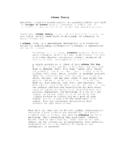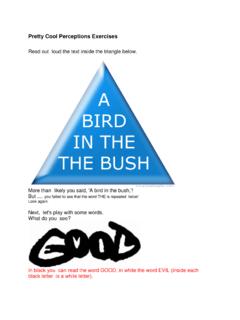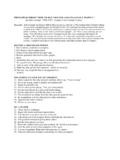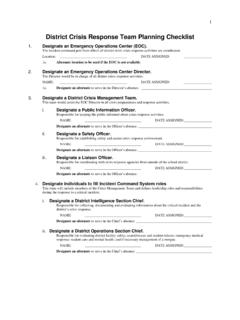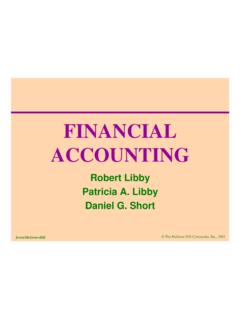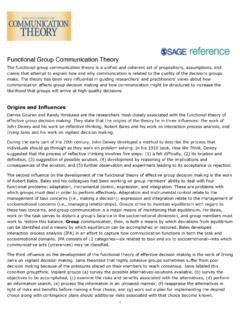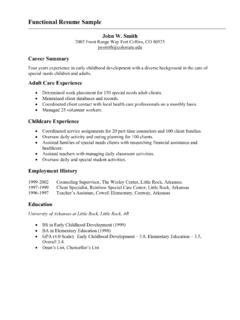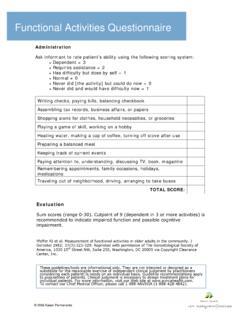Transcription of Functional GroupsFunctional Groups
1 Functional GroupsFunctional Groups Functional group- collection of atoms at a site gpwithin a molecule with a common bonding pattern The group reacts in a typical way, generally independent of the rest of the moleculeindependent of the rest of the molecule For example, the double bonds in simple and complex alkenes react with bromine in the same way (See Figure 3 1)(See Figure )Types of Functional Groups : Multiple bbdCarbon Carbon Bonds Alkaneshave only yC-C and C-H single bonds Alkeneshave a C-C Alkeneshave a CC double bond Alkyneshave a C-C triple bondtriple bond Areneshave special bonds that are tdrepresented as alternating single and double C-C bdi ibonds in a six-membered ring Functional Groups with Carbon Singly ddliBonded to an Electronegative Atom Alkyl halide:C bonded to halogen (C-X) Alkyl halide: C bonded to halogen (CX) Alcohol: Cbonded O of a hydroxyl group (C OH) Ether.
2 Two C s bonded to the same O (C O C)() Amine:C bonded to N (C N) Thiol:C bonded to SH group (C SH) Sulfide: Two C s bonded to same S (C S C) Bonds are polar, with partial positive charge on C ( +) and partial negative charge ( )on( +) and partial negative charge ( ) on electronegative atomGroups with a Carbon Oxygen Double d(bl)Bond (Carbonyl Groups )Bonds are polar with partial positive charge onBonds are polar, with partial positive charge onC ( +) and partial negative charge on O ( )**Organic Structure DeterminationOrganic Structure Determination Spectroscopy = interaction of compounds with ppyplight (a form of energy) E = h = hc/ frequency, wavelength] IR Spectroscopy = used to identify Functional Groups within a compoundAbsorption Spectroscopy Organic compound exposed to electromagnetic gppgradiation, can absorb energy of only certain wavelengths (unit of energy)Titfth lth Transmits energy of other wavelengths.
3 Changing wavelengths to determine which are absorbed and which are transmitted produces anabsorbed and which are transmitted produces an absorption spectrum Energy absorbed is distributed internally in a distinct ddibland reproducible wayInfrared (IR) Absorption IR energy absorption corresponds to specific gypppvibrational and rotational modes, such as bending and stretching of bonds Eiht i tif thti th ftil Energy is characteristic of the atoms in the Functional group and their bondingInfrared (IR) Spectroscopy IR energy in a spectrum is usually measured as gypywavenumber (cm-1), the inverse of wavelength and is proportional to frequency and energy Specific IR absorbed by organic molecule related to Specific IR absorbed by organic molecule related to its bonding structure, principally its Functional Groups Wavenumber = 1 / (cm)_ = K f ( m1+ m2)(mm)stronger bonds = higher heavier atoms=lower ___(m1m2)
4 Heavier atoms lower Csp3-HCsp3-HvsCsp2-HvsvsCsp3-Csp3 Interpreting IR Spectra Most Functional Groups absorb at about the same energy gpgyand intensity independent of the molecule they are in Characteristic higher energy IR absorptions in Table can be used to confirm the existence of the presence of acan be used to confirm the existence of the presence of a Functional group in a molecule IR spectrum has lower energy region characteristic of molec le as a hole ( fingerprint region belo 1500 cm1)molecule as a whole ( fingerprint region below 1500 cm-1) Look for "key" absorptions for Functional Groups , you cannot assign all of the peaks (especially fingerprint region that is unique to a compound) Can only tell you what Functional Groups are in a compound (and what Functional Groups are not in co pou d (a dat u ct o a g oups a e otcompound).)
5 Cannot tell you how many or what exact structure of the IR Absorption Spectrum 4000-2500 cm-1N-H, CHOH (stretching) 2000-1500 cm-1double bonds (stretching)C-H, O-H (stretching) 3300-3600 N-H, O-H 3000 C-H 25002000 cm-1CC and Cbonds (stretching) C=O 1680-1750 C=C 1640-1680 cm-1 Below 1500cm-1 fingerprint 2500-2000 cm-1C C and C N (stretching) Below 1500 cmfingerprint region**(two bands 1600 and 1500)**all values listed are for bond stretchingIR of Hydrocarbons Alkanes, Alkenes, Alkynesy C-H, C-C, C=C, C C have characteristic peaks based on bond strengths absence helps rule out C=C or C C absence helps rule out C=C or C CIR of Aromatics Weak CH stretch at 3030 cm 1 Weak C H stretch at 3030 cm1 Weak absorptions 1660 - 2000 cm 1range Medium-intensity absorptions 1450 to 1600 cm 1 Mediumintensity absorptions 1450 to 1600 cmIR of Alcohols and AminesIR of Alcohols and Amines O H 3400 to 3650 cm 1 Usually broad and intense N H 3300 to 3500 cm 1 Sharper and less intense than an O HCH3CH2OH32IR of Carbonyl
6 Compounds: Aldehydes Strong, sharp C=O peak 1670 to 1780 cm 1g,pp Exact absorption characteristic of type of carbonyl compound (ald, ket, ester, acid, amide, etc) 1730 cm 1in saturated aldehydes 1705 cm 1in aldehydes next to double bond or aromatic ringaromatic ringnote Aldehyde C-H stretches at 2800-2700 cm-1IR of Ketones and Esters17151i ibdi d likt 1715 cm 1 in six-membered ring and acyclic ketones 1750 cm 1 in 5-membered ring ketones 1690 cm 1 in ketones next to a double bond or an aromatic ring 1735 cm 1 in saturated esters 1715 cm 1 in esters next to aromatic ring or a double bondIR of Acids, Amides, Anhydrides, and Acyl Halides Carboxylic Acids.
7 Carboxylic Acids: O-H 2500-3300 cm-1 (very broad, strong) C=O 1710-1760 cm 1 (dimers lower, monomers higher ) Amides: N-H 3300-3500 cm-1 (sharp, medium, varies with # of H's) C=O 1690 cm 1 in saturated amides Anhydrides:yd des C=O 1820 and 1760 cm-1 (two absorptions) Acyl Halides: Acyl Halides: C=O 1800cm-1IR of Ketones and AcidsIR of Ketones and AcidsMatch a structure from the list below to the IR a structure from the list below to the IR a structure from the list below to the IR a structure from the list below to the IR a structure with formula C4H8O that fits dataPropose a structure with formula C4H8O that fits dataHow would you differentiate each pair of molecules below using IR spectroscopybelow using IR spectroscopy(a)and(b)andOHNH2(b)and(c)
8 AndOHNaOH,H2 OfromBr,213C NMR Spectroscopy Intro Provides a method to count the number of different (non-equivalent) carbons in a molecule Will also give information about the chemical environment around each carbon atom (ppm scale)sp3 C signal is at 0 to 9 sp2C: 110 to 220C( O) at low field 160 to 220C(=O) at low field, 160 to 220 Identify Equivalent CarbonsOOOOFOOH13C NMR SpectroscopyHow many signals would you expect to see in the 13C NMR spectrum of each of the following compounds?OOHThe Simplest FG: AlkanesThe Simplest FG: Alkanes Alkanes.
9 Compounds with C-C single bonds and C-H bonds only (no other Functional Groups ) Connecting carbons can lead to large or small molecules The formula for an alkane with no rings in it must be gCnH2n+2where n is the number of carbon atoms Alkanes are saturatedwith hydrogen (no more can be added They are also called aliphatic compounds All C sp3hybridized withtetrahedral geometry (if no charge)charge)Alkanes & Isomerscompounds with same molecular formulabut different arrangement of atomsAlkanes & Isomers CH4= methane, C2H6= ethane, C3H8= propanebut different arrangement of atoms4,26,38pp The molecular formula of an alkane with more than three carbons can give more than one structure C4 (butane) = butane and isobutane C5 (pentane)
10 = pentane, 2-methylbutane, and 2,2-dimethylpropaneyp p Alkanes with C s connected to no more than 2 other C s are straight-chainor normal alkanes Alkanes with one or more C s connected to 3 or 4 C s are branched-chain alkanesisobutanebutaneConstitutional Isomersisomers that differ byatomic connectivityConstitutio



